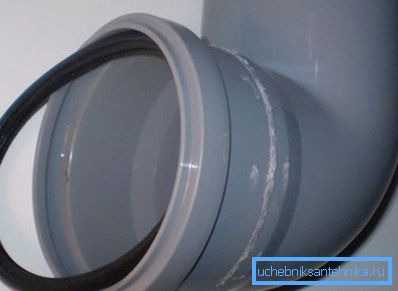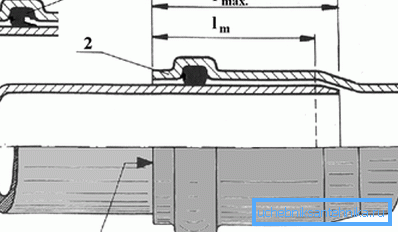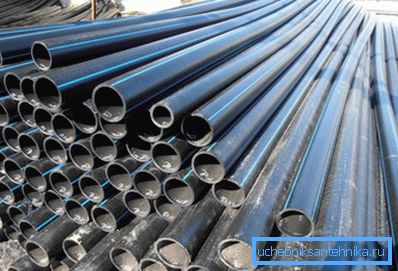Polyethylene pipes for sewage: technical characteristics
At present, in order to equip an autonomous sewage system in a country house or to set up a sewer network in a private apartment, instead of an obsolete cast iron cast iron, plumbing products made of a completely different material are used. Modern polyethylene pipes for sewage according to GOST fully comply with all engineering, sanitary and construction standards, have low weight and almost unlimited service life.

Use of polyethylene pipes
In order to help the reader learn to understand such products well, this article will provide a detailed description and basic technical parameters of polyethylene sewage pipes that can be used during an apartment renovation or construction of your own house.
Also, the reader will be offered a brief instruction that describes the basic rules and technological features of working with this type of product.

Specifications
Plastic sewer pipes are made of low-pressure polyethylene by hot extrusion, followed by calibration in a vacuum chamber. This technology allows you to get in one batch of absolutely identical finished products that have the correct shape and a uniform smooth surface.
All modern polyethylene sewer pipes according to GOST 22689.2-89 "Polyethylene sewer pipes and fittings to them. Construction "must comply with the following technical parameters:
- The total length of the finished product, depending on its purpose, may be 0.5 m; 1m; 2 m; 3m; 6 m; and 8m.
- The outer diameter of plastic sewer pipes can range from 40 to 1,200 mm, but in individual residential construction the most commonly used dimensions are 40 mm; 50 mm and 110 mm.
- The thickness of the wall material can be 2.5 mm; 3 mm and 3.2 mm, while for mounting outdoor and underground communications it is allowed to use products with a wall thickness of at least 3.2 mm.
- The rated operating temperature of operation shall not exceed +45 ° C. At the same time, a short-term temperature increase of no more than +60 ° C is allowed.
- All the elements are interconnected by means of a socket, into which a special-profile rubber seal is installed, or by means of thermal welding.

Note! As a symbol of such products, the abbreviation TK (sewer pipe) is used, followed by a diameter in mm, then length in mm, followed by the name of the material from which it is made and the name of the standard. For example, the marking of shopping mall 110-3000-PND GOST 22689.2-89 says that it is a sewer pipe with an outer diameter of 110 mm, a length of 3 m, made of low-pressure polyethylene in accordance with GOST 22689.2-89.
Main advantages
Considering the comparative characteristics of cast-iron and plastic sewer pipes, it is easy to understand that products made of polymeric materials occupy a more advantageous position, because they have a number of undeniable positive qualities.
- Modern polyethylene pipe for sewage is not susceptible to corrosion and is absolutely not afraid of exposure to water, acids, alkalis, oil products and other corrosive media., therefore, it can be used to transport both domestic and industrial waste.
- Estimated period of operation is at least 50 years, that significantly exceeds the service life of similar products from other materials.
- When external installation or laying in the ground such a system does not require the use of waterproofing, and during the operation does not need annual maintenance and repair.
- Low thermal conductivity of the material reduces the effects of low ambient temperature, so there is no need for additional thermal insulation.
- Smooth inner surface allows unobstructed passage of sewage system, thereby reducing the likelihood of silt deposition and the formation of blockages.
- Low specific weight and low price of material significantly reduce the cost of repair or construction work.

Note! Flared connections of plastic sewage pipes are collapsible, so if necessary, the entire system can be easily dismantled or refitted in a short time.
The disadvantages of polyethylene pipes
Despite all the positive qualities, sewage pipes made of polymeric materials are inferior in some respects to shaped articles made of cast iron.
- The noise absorption of thin walls made of polyethylene is much lower than that of a thick cast-iron pipe, therefore, when installing an in-house sewer network, additional noise insulation may be required.
- The insufficiently high mechanical strength of polymeric materials does not allow building communications under considerable load conditions (at great depth or under the road) without additional reinforcement of the ground with the help of hollow reinforced concrete ducts.
- Polyethylene is poorly resistant to direct ultraviolet radiation, so products from it are recommended to be used only for internal or underground laying of communications.

Tip! It must be remembered that products made of polyethylene with a socket connection can be used only on gravity-free gravity sewer systems.
Features of application in housing construction
The technology of installing a home sewer network using polyethylene pipes and the corresponding fittings is quite simple and does not require the use of special tools, so it can be done by any apartment owner with your own hands without any help.
- Before installation, you need to correctly calculate the entire sewage system, and in accordance with this calculation to purchase the necessary materials and components.
- To connect the two elements together, you need to make sure that the rubber seal is in place, then insert the pipe into the socket and press it with moderate effort, pushing it deep into the stop.
- Before laying in the ground, it is necessary to pour a sand pad at least 50 mm thick under the sewer pipe.

Tip! To reduce friction between the pipe and the seal, before installation it can be lubricated with a building silicone sealant, which after drying will provide additional tightness of the joint.
Conclusion
After reading this article, we can conclude that plastic pipes made of polyethylene are the most optimal solution for installing or repairing a domestic sewer network. (See also the article How to make sewage in the house: features.)
For more information on the subject of interest, you can watch the video in this article or read similar materials on our website.